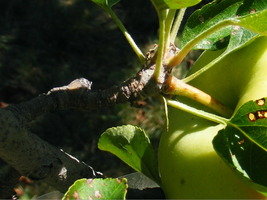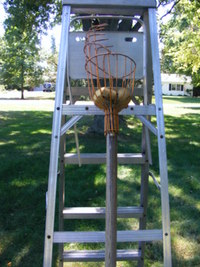





Fall is apple picking time! Whether you have your own fruit trees or visit a "Pick Your Own" orchard, the best apples are the ones you pick yourself, fresh from the tree. Here are some tips for successful apple picking.
The first thing you need to know is when the apples are ripe. Not all varieties ripen at the same time. Here in Zone 5, the earliest apples like 'Lodi' may be ready to pick in July, while 'Granny Smith' doesn't ripen until November. So it's important to know what varieties you are growing and what they are supposed to look like when ripe. It's easiest when apples turn red, but some varieties are green when ripe, so that method doesn't always work.
Towards the end of summer, I go out to my apple trees on a regular basis to check on their progress. I look for a change in color. And every day or so, I pick one and eat it. Near-ripe apples are edible, if tart, and their seeds are white. When the seeds begin to turn dark, I know they are almost ready. When the seeds are completely dark, it's time to start picking.
Another way to tell if the apples are ripe is when they start dropping from the tree. An apple tree will drop unsound or damaged fruit before the crop is ready, but if there is sound fruit on the ground, it's probably ripe. The problem is, it might by this time be over-ripe, so I prefer to rely on the color of the seeds. Apples picked earliest are likely to be better keepers; the riper the apple when it's picked, the more likely it is to be soft or mealy, the quicker it is to go bad in storage.
 Finally, you know that an apple is ripe and ready to pick when you can lift it off the tree without pulling hard or twisting.
Finally, you know that an apple is ripe and ready to pick when you can lift it off the tree without pulling hard or twisting.
To understand how to pick an apple, it helps to know how it grows. The apple blossoms of spring are formed in the previous year on spurs, short stubs that grow from the branches or twigs. Each blossom may become an apple; one or more apples will grow from a single spur. Where the stem of the apple joins the spur is called the abscission layer. The cells at this point are programmed to die as the fruit becomes ripe, until the stem releases entirely from the spur and the apple falls to the ground.
The ideal time to pick an apple is when it is almost ready to let go by itself. Lift the apple gently. It should release easily and come away in your hand. If it resists, it's not ready. Move on to the next apple. Not all apples on the same tree are ripe at exactly the same time.
Pulling forcibly or twisting the apple is likely to tear off the spur, where the next year's buds are already beginning to form. Spurs are easily broken off; if too many are destroyed, there may not be enough apples next year.
Do not pull the apple off its stem. This leaves a wound in the fruit where rot can develop in storage. Sometimes there are two apples joined together on the same spur. In this case, you should pick them both at once, lifting them off the spur together.
When you have picked your apples, be sure to treat them gently. Don't drop them into the bucket or sack. Ripe apples bruise easily, and bruised apples may rot.
 Most home gardeners these days grow dwarf fruit trees so they can reach the apples without having to climb a ladder. But trees can grow taller than you expect. In case your apples are higher than you can reach, a home stepladder is useful, as long as you are not careless and don't stand on tiptoe from the very top of the ladder to reach that apple just beyond your grasp. A small bucket where you can place the fruit as you pick fits nicely on the fold-down shelf.
Most home gardeners these days grow dwarf fruit trees so they can reach the apples without having to climb a ladder. But trees can grow taller than you expect. In case your apples are higher than you can reach, a home stepladder is useful, as long as you are not careless and don't stand on tiptoe from the very top of the ladder to reach that apple just beyond your grasp. A small bucket where you can place the fruit as you pick fits nicely on the fold-down shelf.
Things get more problematic if your tree is taller than ten or twelve feet. Special orchard ladders, with three legs, are expensive, and propping an extension ladder against a tree can risk a fall. In addition, the pickers need sacks hanging from their necks to hold the apples as they are gathered. Many suppliers sell wire harvesters that attach to a pole for extending your reach, but I have found that these tend to break off a lot of spurs from the tree, as they pull the apple down instead of lifting it. It can be frustrating to see your fruit up so high out of reach, but the solution may be to prune back the tree instead of climbing higher.
Most commercial "Pick Your Own" orchards these days also feature dwarf trees or trees that have been pruned low enough that pickers can reach the fruit from the ground, as concern for liability keeps them from wanting to see their customers up on a ladder where they might fall. Be advised that picking your own apples from a commercial orchard is not the best way to save money. These apples may cost a lot more than you would spend at the grocery store. Part of the reason is the damage that inexperienced pickers, especially children, do to the trees. Learning the right way to pick apples will make you a welcome visitor to an orchard and it will help you make the most of the fruit that is growing on your own trees.
(Editor's Note: This article was originally published on September 12, 2008. Your comments are welcome, but please be aware that authors of previously published articles may not be able to promptly respond to new questions or comments.)
Copyright © www.100flowers.win Botanic Garden All Rights Reserved